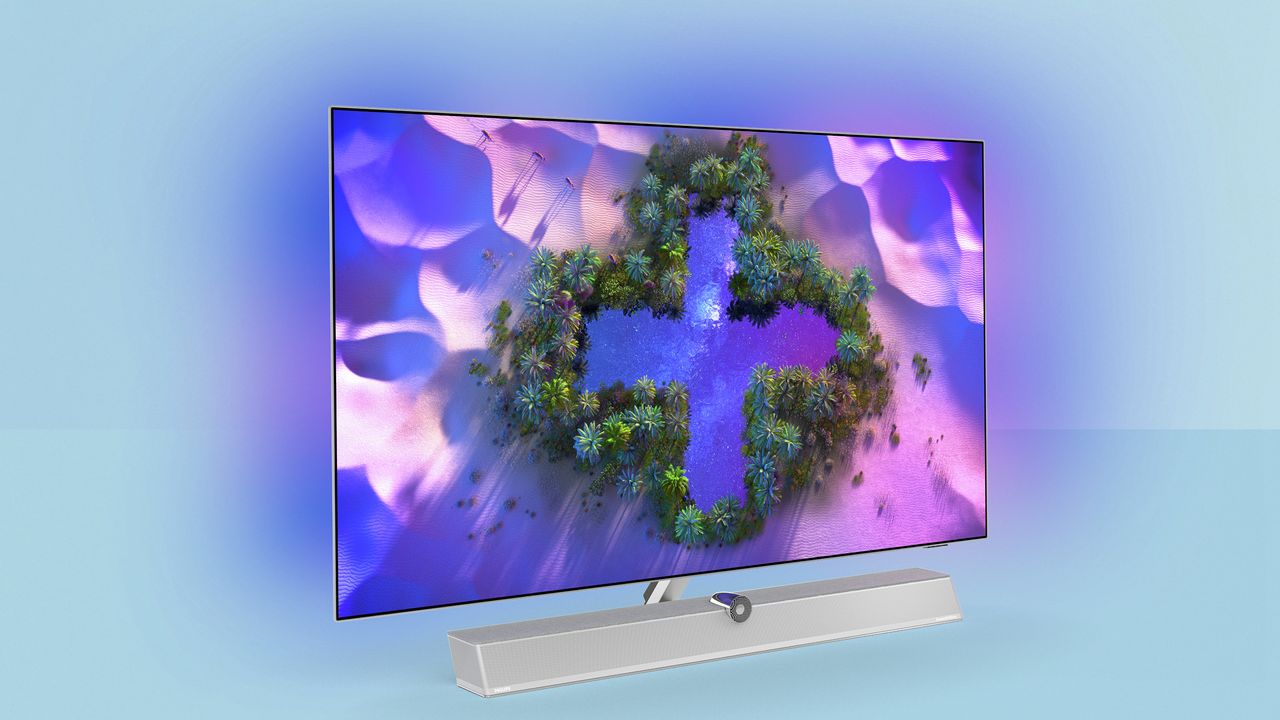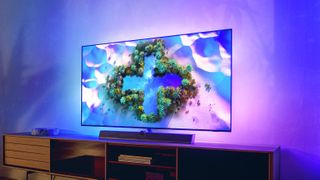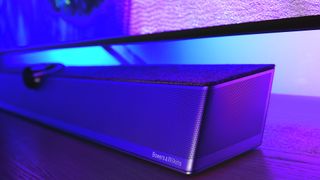Philips OLED+936 review: elite 4K TV quality and Dolby Atmos sound in a top-value package
The Philips OLED+936 takes big strides forward for both visuals and audio, making it one of today's best TVs, no question


The Philips OLED+936 is a premium OLED TV that’s as stylish as it is innovative. Combining category-defining AI image processing and high-fidelity Dolby Atmos audio, with artisan elegance, it’s the AV equivalent of the poshest popcorn. We rate it as delicious.
-
+
Outstanding image quality
-
+
High performance Dolby Atmos speakers
-
+
Anti-burn-in technology
-
+
HDMI 2.1 support
-
-
Only two HDMI 2.1 inputs
-
-
Average input lag for gaming
Why you can trust T3
Our Philips OLED+936 TV review in a nutshell: jaw dropping! Picking up where last season’s OLED+935 left off, this 2021 update improves on virtually every aspect of its highly rated predecessor. Once again, it's an OLED TV with a soundbar-like speaker system attached, and both elements have been upgraded powerfully, making it a seriously impressive all-in-one home cinema upgrade.
Behind the glass (more on that below), the OLED+936 boasts a dual-chip image processor, which allows for even smarter image adjustments, including the craftiest anti-screen burn measures we've seen to date (good news for gamers), while below the glass there's a revamped audio system from Bowers & Wilkins, which delivers higher-fidelity Dolby Atmos audio (good news for movie fans).
And it still looks like something even the fussiest interior designers might welcome (no easy feat).
Meanwhile, a next-gen OLED panel means it's brighter than previous Philips TVs, and is a real competitor to the might of the Panasonic JZ2000 or Sony A90J – yet costs much less than either, and even beats the LG G1 on price, and that doesn't have an elite built-in sound system. This deserves to blow up a lot of people's high-end TV upgrading plans.
Philips OLED+936 TV review: Price & release date
The OLED+936 is available in three screen sizes: the bijou 48-inch 48OLED+936, populist 55-inch 55OLED+936, and cinematic 65-inch 65OLED+936, priced around £1,800, £2,100, and £3,000 respectively. On our test bench is the 65-inch model.
If you’re Stateside and interested then we have bad news. There’s no US equivalent, because Philips TVs there are made by a totally different company There, you'll need to focus on the Sony A90J as the closest equivalent.
We do expect the OLED+936 to launch in Australia, although there are no details to report as yet.

Philips OLED+936 TV review: Features & what's new
Philips has loaded this screen like a potato in TGI Fridays. For starters, there’s the panel, which is the latest 'OLED evo' design from LG Display (which makes the displays in all OLED TVs) in the 55-inch and 65-inch screens.
This all-new OLED panel is capable of higher brightness and greater colour vibrancy. We’ve seen it before in other high-end OLED TVs, including the LG G1.
It's worth noting that this higher-brightness panel is not used in the 48-inch version of the OLED+936, simply because LG Display doesn't make it in that size. Instead it uses the same OLED glass found in the rest of the Philips 806 range.
That doesn’t mean that the OLED+936 mirrors the LG G1's performance. It’s not the glass which determines image characteristics (although it obviously plays its part), but the processor which is responsible for ends up onscreen – and Philips' approach is rather different to its rival.
The fifth iteration of the brand’s P5 processor, here in AI Intelligent Dual Picture Engine guise, enables a raft of enhancements.
Perhaps the most significant, certainly when it comes today-to-day viewing, is Ambient Intelligence. This is the ability to measure and react to available room light using the TV’s sensor, adjusting the image accordingly to maintain the best contrast and brightness.
Then there’s its innovative anti-screen burn mode, wherein the set automatically scans for static elements in an image, and then dims them to prevent image retention. Really clever stuff! This is available on all of Philips' current OLED TVs, but the dual-chip processor enables this set to scan in a grid with 32,400 zones for static images and to dim only those areas with total precision; the OLED806 features 840 zones, so will end up dimming a small area around the static image too.
There’s also a new Film Detection mode which allows the set to automatically toggle either Filmmaker Mode or an all-new Home Cinema preset when the TV senses that you're watching a movie (thanks to its AI detection smarts). You can flip between the two in the menu system.
Top marks go to this Home Cinema setting. Railing against conventional cinema mode wisdom, it offers cool whites, high contrast and a vibrant colour palette, but no overt motion nasties. A halfway house between FilmMaker mode and the indecent richness of Vivid – I really like it.
The set also brings back four-sided Ambilight (for a while, three was in vogue), and this means the entire screen can sit in a puddle of pulsating light. Four-sided Ambilight is particularly effective when the screen is wall mounted.
Ambilight is one of those features you probably won't care about until you actually try it, and then it's hard to go back. It's so pleasant to have the colours from the screen spread out onto the wall, making the picture feel even bigger than it is. You can decide how vibrant you want the effect to be (or deactivate it, you animal).
The set is also DTS Play-Fi compatible, meaning it’ll recognise and work alongside other Play-Fi certified speakers for multi-room audio.
HDMI 2.1 inclusion is one of the major additions in this model, and it supports Variable Refresh Rate (including Nvidia G-Sync and FreeSync Premium), 4K 120Hz and Auto Low Latency Mode.
The speaker system from Bowers & Wilkins has also been upgraded – like its predecessor, you get three tweeters, three woofers, a bass unit and two upfiring drivers. But the system has been majorly overhauled, thanks to eARC support in the TV, improved circuitry within the speaker setup, and improvements to the drivers themselves.

Philips OLED+936 TV review: Picture quality
Philips continues to do extraordinary things when it comes to image processing, pioneering techniques that pull detail seemingly out of thin air. It’s extraordinarily good at giving non HDR content a comparable dynamic lift, and closing the subjective gap between regular HD and native 4K.
The brand says the newly improved Perfect Natural Reality circuitry at work in the OLED+936 has enhanced highlight detection and finds up to 30 per cent more sharpness thanks to AI processing – and this certainly rings true.
Similarly, AI Smart Bit Enhancement 2.0 (another new recipe from Philips’ image kitchen) effectively eliminates colour banding, by extending 8-bit video to 14-bit precision in troublesome areas. Sunsets and animated gradations are silky smooth – they look close to real life, not like they're struggling with artificial colours.
Occasionally, you suspect the screen is over-emphasising grain, but when you look again, it appears perfect. Picture depth is tangible.
New Ambient Intelligence makes real time adjustments to the set’s contrast handling, noise reduction and HDR management, reacting to available light in your viewing room. It operates when the set is in Dolby Vision Bright mode. Alternative Dolby Vision presets include Personal, Vivid, Dark and Game.
Other new niceties include an opt-in Film Detection mode, which offers the opportunity to automatically view movies in Filmmaker Mode (no FMM flag required), or an all-new Home Cinema preset. You can set your preference in the set’s menu system.
This new Home Cinema setting proves to be rather excellent. It boasts cool whites, high contrast and a vibrant colour palette, all without inducing motion artefacts. I found it a good deal more engaging than the dourer FilmMaker mode.
It goes some way to replicating the kind of visual pop you’ll see at a premium laser cinema (think IMAX Laser or Sony Finity), and really adds punch to spandex blockbusters.
HDR format support is wide. In addition to Dolby Vision, there’s HDR10+ Adaptive, HLG, regular HDR10 and game specific HGiG HDR – Sony and LG don't offer support this broad, and neither does Samsung on its QLED TVs.
Peak HDR brightness is high. We measured the screen at a sniff under 950 nits, using a 10 per cent measurement window. This makes it one of the top performers for its class – right alongside the Sony A90J and Panasonic JZ2000, and besting the LG G1. Black levels, near shadow detail and contrast consistency all impress.
Latency is good but not remarkable. Philips has told T3 it expects a latency of around 10ms here, but I actually measured input lag at 21.6ms in Game mode (1080/60). That's okay (under 30ms is acceptable), but other sets tend to hit 10ms or less, so while this is fine for the majority of gamers, those playing the most intense competitive stuff may prefer something with quicker responses.

Philips OLED+936 TV review: Audio quality
Sonically the set also wows, thanks to the slightly revised Bowers & Wilkins sound enclosure. B&W’s characteristic 'Tweeter on Top' remains a crowning glory, offering supreme dialogue articulation, but there have been significant changes internally, with various component upgrades, that have improved width and steerage.
The boffins at Bowers have upgraded crossover components and improved voice coils for the mid-range drivers, made constructional tweaks to the tweeters, and stiffened the bass driver. They’ve also slightly changed the direction of the upfiring Dolby Atmos drivers.
All these relatively small changes have led to an altogether bigger sound stage. There’s a more pronounced sense of travel as objects are panned across the front soundstage, and a more immersive height component too. This doesn’t just manifest itself on action movies (explosions rock), but is evident on subtle atmospherics too, be they incidental interior noises or natural sounds (bird songs, trees rustling, that kind of thing).
Total power output is rated at a brawny 70W. This is usable muscle too, as the set doesn’t easily distort. If you want more power, there is a subwoofer output connection. HDMI eARC to external speakers is also supported, though is superfluous for most buyers of this TV.
There are various sound presets available, but our advice is to leave it on AI Mode, as this actually runs automatic surround optimisation by Dolby.

Philips OLED+936 TV review: Design & usability
The OLED+936 looks distinctly upmarket. The panel is held in a premium steel frame, and is predictably wafer thin. It bulges out for electronics, connectivity and Ambilight LEDs, but not by much. The Bowers & Wilkins sound system is integrated into the short pedestal stand, connected to the panel via a captive cable.
This sound system may look like the Bowers & Wilkins and Philips collaboration on the previous model, but the aluminium micro mesh grille on the soundbar now faces forward, while grey Kvadrat acoustic fabric hides the up firing Dolby Atmos drivers up top.
The remote control is a premium handful, with dedicated buttons for Netflix, Prime Video and Rakuten TV.
Smart functionality comes from Android 10. The platform is polished and stable, with excellent streaming options. Freeview Play ensures all your catch-up TV addiction will be well served too. There’s a satellite tuner option if you’re dish-centric.
Philips OLED+936 TV review: Verdict
The OLED+936 is ground-breaking premium OLED TV that combines innovative features with elite picture performance and thrilling Atmos audio. If you’re short-listing the world’s best TVs, it warrants high inclusion – especially if you want a single purchase that covers audio and visuals all in one, rather than trying to figure out the best TV and soundbar combo.
Design details, like that Kvadrat topped sound system, help the set stand apart from the crowd, while the new dual chip P5 image processor pushes the latest OLED panel technology from LG Display like nothing we’ve seen before.
And it's fantastic value too – cheaper than the competition of equivalent brightness and sound capabilities by a long way.
This is a screen you’ll ache to watch each and every day. It’s a corker.
Philips OLED+936 TV review: Also consider
The flagship Panasonic JZ2000 is arguably the most cinematic of all the 2021 OLEDs. It boasts a brilliant Master HDR OLED Professional Edition panel, coupled to an all-new processor, dubbed HCX Pro AI, which delivers supreme detail, texture and colour richness. The set offers broad HDR support, including Dolby Vision IQ and HDR10+ Adaptive, and has a built-in Dolby Atmos sound system that not only goes high and wide, but offers proper immersive effects too. It's a strong competitor here for quality, but comes in at a much higher price – our Panasonic JZ2000 review goes into more detail.
The Sony A90J is another ultra-premium OLED with very fancy sound quality and simply phenomenal processing of its own, directly competing with Philips when it comes to aspects such as upscaling sharpness and making SDR video look more like HDR. Our full Sony A90J review talks about where that set excels – but again, it's much pricier than the Philips.
The LG G1 is LG’s 4K OLED range-topper for 2021. Designed for wall-mounting, it’s the only screen in the LG line-up to use the new high-performance OLED evo panel. This is coupled with the brand’s 4th gen Alpha 9 image engine, which overflows with advanced AI enhanced processing. All its HDMI inputs are HDMI 2.1-capable too. However, while it has Dolby Vision, it lacks support for HDR10+, and its peak brightness doesn't match the Philips (or the two TVs above). You'll also need to add a soundbar for cinematic audio, yet the G1 costs around the same as the Philips. Here's our full LG G1 review.
It's worth noting that none of the above comes in a 48-inch model, so the main competitor in the smaller size is the LG C1. That's a hard decision between that and the Philips, because the Philips doesn't have the clear brightness advantage (that size doesn't use the new panel, remember), and they're both equipped with the latest and greatest AI processing. The Philips is more expensive, but then it has the excellent sound system built in – the LG C1's audio is totally pedestrian. Here's our LG C1 review for more about that model, which we rate really highly.
Sign up to the T3 newsletter for smarter living straight to your inbox
Get all the latest news, reviews, deals and buying guides on gorgeous tech, home and active products from the T3 experts
For over 25 years, Steve has been casting his keen eyes and ears over the best that the world of TV and audio has to offer. He was the creator of Home Cinema Choice magazine, and contributes to huge range of technology, home and music titles along with T3, including TechRadar, Louder, Ideal Home, the i newspaper, and more.
-
 Dior rounds off Paris Fashion Week with new Dior Grand Soir Automate collections
Dior rounds off Paris Fashion Week with new Dior Grand Soir Automate collectionsDior debuts three Dior Grand Soir Automate watches with new dial designs
By Bethan Girdler-Maslen Published
-
 This griddle and air fryer combo is the outdoor appliance I never knew I needed
This griddle and air fryer combo is the outdoor appliance I never knew I neededBlackstone finally arrives in the UK with new Griddle Airfryer Combo
By Bethan Girdler-Maslen Published
-
 KIPRUN’s latest shoe ditches glue to run toward a more sustainable future
KIPRUN’s latest shoe ditches glue to run toward a more sustainable futureInnovative new technology cuts a 15-step process to just one
By Matt Kollat Published
